
Mobile-Cloud-Overview-POV
.pdf
Point of View
The Mobile Cloud: When Two Explosive Markets Collide
Cisco IBSG Research Uncovers New Opportunities for SPs To Prosper in This Rapidly Growing and Evolving Market
By Stuart Taylor, Andy Young, Neeraj Kumar, and James Macaulay
The growth of mobility, and the way it has fundamentally changed our lives, is unprecedented. Close to 80 percent1 of the world’s population now has access to a mobile phone, and new devices like the iPhone and Android smartphones are bringing a host of applications and services to the palms of people’s hands.
At the same time, cloud has become the new way of delivering—and charging for—IT services and functionality. Technology services and apps are increasingly being delivered and paid for on-demand from remote data centers, accessible through the “cloud” of interconnected networks that constitute the Internet. Everything from email, content storage, and applications like Salesforce.com to more complex computing and development platforms can now be accessed through simple browsers and delivered through the cloud, eliminating the need for end-user applications and high-powered computers.
So, what happens when two of the hottest technology trends—“mobility” and “cloud”— collide?
To find the answers, the Cisco® Internet Business Solutions Group (IBSG) Research & Economics Practice conducted a survey of 1,016 U.S. mobile users to understand their current and future needs, and to learn how they prefer to pay for mobile cloud services.2 The research findings are important because they allow service providers (SPs) to understand the size of the opportunity, develop strategies for success, and differentiate their offerings to become more competitive.
Mobile + Cloud—What Does It Mean?
Before we explore the research findings, it is important to establish a common understanding of what “mobile cloud” means. Cisco IBSG defines it as mobile services and apps delivered from a centralized (and perhaps virtualized) data center to a mobile device such as a smartphone.
Cisco Internet Business Solutions Group (IBSG)
Cisco IBSG © 2011 Cisco and/or its affiliates. All rights reserved. |
06/11 |

Point of View
Customers access these services on-demand using the browser or thin client on their mobile devices. This contrasts to “thicker” clients that are downloaded from app stores and reside (and run) on the mobile device. Mobile cloud services are agnostic about the type of device or operating system on which they run.
Mobile cloud comprises two categories of services:
●Traditional cloud services: The extension of traditional, wired cloud services (Saas, Iaas) to mobile devices (e.g., Mozy, Salesforce.com)
●Unique mobile cloud services: Services that exploit features of the mobile device (e.g., camera, voice recognition) and the characteristics of mobility (e.g., location, presence) to create unique, cloud-delivered offerings (e.g., bar-code scanning, realtime translation)
Top 10 Research Findings
Findings from the Cisco IBSG research will have a powerful impact on the ability of SPs and other companies to take advantage of explosive growth and new possibilities in the mobile cloud market. This paper provides an overview of the research findings. Additional details and insights are included in three white papers that are part of the Mobile Cloud Watch thought leadership series. The first paper focuses on consumers and their perspectives about the mobile cloud; the second describes enterprise mobility and the mobile cloud; and the third explores trends in device usage and the role of devices in the mobile cloud. Here are the top 10 overall findings:
1. Mobile users want to move to the cloud. Cisco IBSG believes cloud-delivered services (e.g., storing, sharing, conferencing) will explode over the next several years. In fact, 70 percent of all mobile users expect to consume these capabilities in the next one to two years (see Figure 1). Additionally, users are interested in a mobile cloud-based virtual desktop infrastructure (VDI) service that would allow them to arrange a computer desktop to reflect their personal preferences and view the same configuration on any mobile (or other) device they log into.
There was a high level of interest in a service that would allow users to access personal content such as video, photos, and music stored on a home computer or elsewhere. Mobile users recognize the mobile cloud is essential for delivering access to personal content anytime, anywhere, on any mobile device.
2. Mobile users want unique mobile cloud services. The research showed mobile users want more than just mobile access to wired cloud services. Ideally, they would like to exploit the cloud to experience new services that combine the unique capabilities of their mobile devices with the benefits of mobility. For example, users are interested in combining the microphone and speaker capabilities of their devices to do real-time voice translation (see Figure 1).
Equally, mobile users expressed great interest in having an easy-to-use dualpersona capability on their devices, such as “business and personal” or “student and entrepreneur.” They are also eager for services that will allow them to transfer multimedia files across devices and use augmented reality to take a picture of an object and receive real-time information about it.
Cisco IBSG © 2011 Cisco and/or its affiliates. All rights reserved. |
Page 2 |
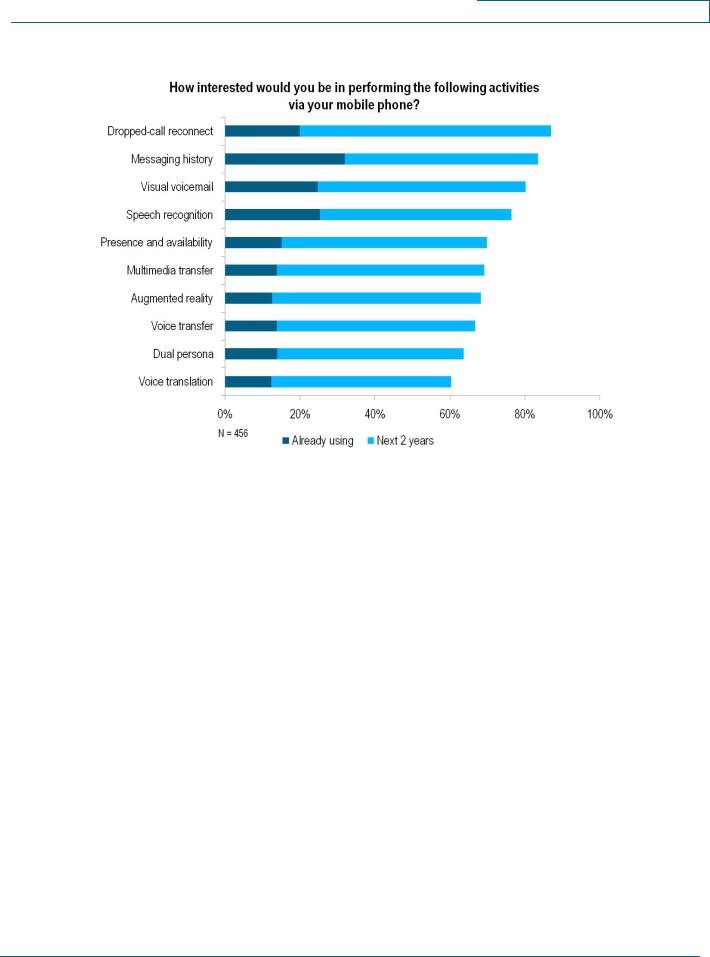
Point of View
Figure 1. Future Use of Next-Generation Mobile Services (Smartphone Users).
Source: Cisco IBSG, 2011
3. Business users will be key adopters of mobile cloud services. Businesspeople are already much bigger users of PC-based cloud services—for example, photo and video sharing, file storing, and web conferencing—than consumers. Business users’ familiarity with the value of PC-based cloud services will make them key adopters of similar and next-generation services over the cloud (see Figure 2). In every case, business users outpaced consumers when asked how interested they would be in performing a list of activities on their mobile phones.
Business users will be quick to adopt mobile services such as dropped-call reconnect, visual voicemail, and messaging history to make them more effective and productive employees. Equally, they are interested in dual-persona services delivered through the cloud that will let them better manage their work and personal lives on their mobile devices. Lastly, business users will be big adopters of mobile conferencing, document management, and specific business apps, permitting them to extend the boundaries of their offices.
4. Smartphones will become the primary mobile device. Almost half (45 percent) of survey respondents owned smartphones. Even more remarkable, up to 60 percent of U.S. mobile phone subscribers could be smartphone users by the end of 2013. While Apple, BlackBerry, and Android devices represent the “big three” of smartphones, almost 20 percent of respondents were unaware of their smartphone operating system. This suggests they were buying a specific device rather than a broader mobile ecosystem.
Cisco IBSG © 2011 Cisco and/or its affiliates. All rights reserved. |
Page 3 |
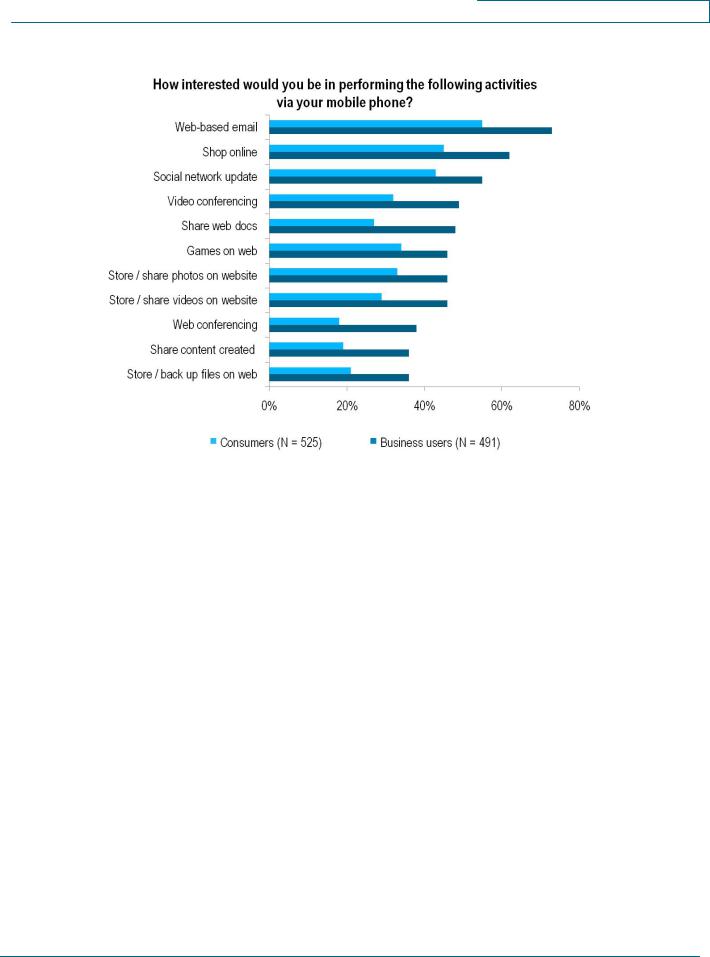
Point of View
Figure 2. Future Adoption of Mobile Cloud Services (Business Users and Consumers).
Source: Cisco IBSG, 2011
5. Mobile is now much more than voice. Where voice calling once defined mobile, it is now just another application or function for most smartphone users. In fact, voice calling ranked as the fifth-most-used function by business users (see Figure 3). Both business users and consumers are much more interested in using their smartphones for texting and taking photos, which ranked first and second, respectively. In addition, business users, given their frequent use of smartphones for both their work and personal lives, are the largest adopters of more advanced types of hybrid (business and personal) services, such as apps, playing games, mapping, videos, and social networking. And, of course, business users are the largest users of more work-centric features such as productivity tools, business applications, and conferencing.
Cisco IBSG © 2011 Cisco and/or its affiliates. All rights reserved. |
Page 4 |
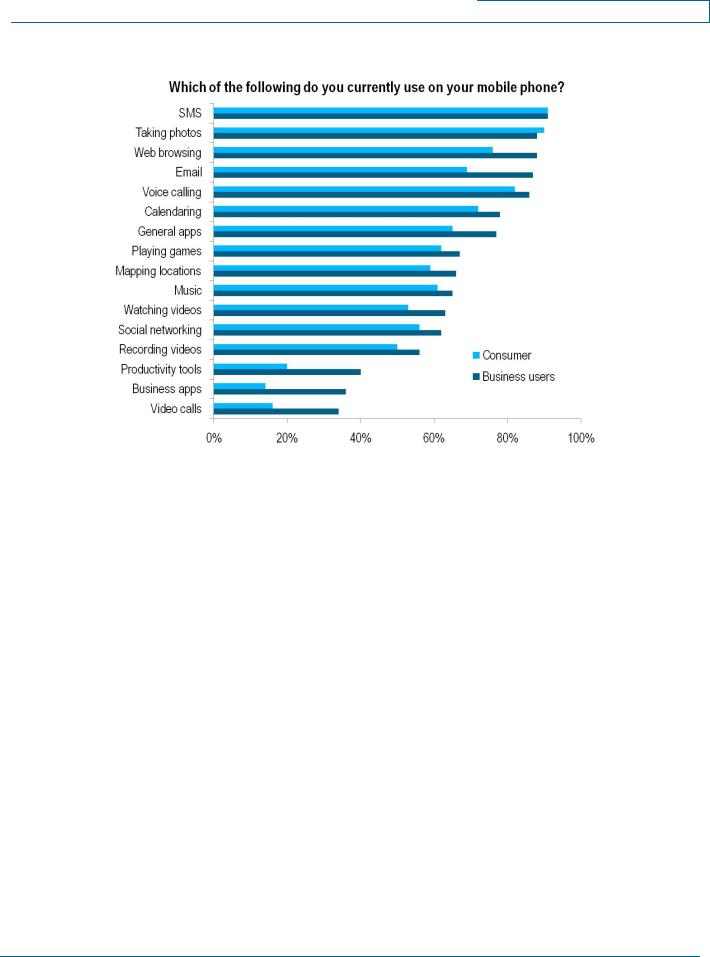
Point of View
Figure 3. Current Use of Mobile Phone Features (Consumers Versus Business Smartphone Users).
Source: Cisco IBSG, 2011
6. Smartphone growth will drive adoption of mobile cloud services, creating a “virtuous circle.” Smartphone growth and adoption of mobile cloud services are intimately linked, forming a virtuous cycle that is characterized by:
–Platform. Larger screens, alphanumeric keys, and other smartphone features provide the platform and capabilities required for users to access and fully benefit from cloud services.
–User profile. The technical savviness of today’s smartphone users opens the door for greater interest in advanced mobile services. Not only does this demographic represent the early adopters of these services today—smartphone users will be the key drivers and consumers of mobile cloud services in the next two to three years.
–Vision and familiarity. Many smartphone users are already comfortable using both PC-based and mobile cloud services. Equally, these users can see how mobile cloud services drastically expand their mobile capabilities and provide needed security for peace of mind in their increasingly mobile-centric lives.
–Accessibility. Offloading smartphone capabilities to the cloud will not only reduce device prices and make smartphones more secure—it will enable a better customer experience. Overcoming these key inhibitors to smartphone adoption will encourage more users to purchase smartphones and begin to explore the mobile cloud world.
Cisco IBSG © 2011 Cisco and/or its affiliates. All rights reserved. |
Page 5 |

Point of View
7. Mobile security is the most appealing attribute of the mobile cloud. Security ranked as the most important attribute of the mobile cloud (see Figure 4). Users recognize the growing importance of mobile devices in their lives, and understand how difficult life would be if their device were lost, stolen, or damaged. People also recognize the key value proposition of the mobile cloud—storing all of their critical information, media content, and apps in one place, where they can be readily accessed and retrieved.
Figure 4. Mobile Cloud’s Most Appealing Attributes (Smartphone Users).
Source: Cisco IBSG, 2011
8.Social networking and video are ready to explode on mobile devices. All forms of video—watching, recording, and conferencing—are poised for significant growth, with 70 to 80 percent of all respondents expressing intent to use these features on their smartphones (see Figure 5). Visiting and updating social networks will be the biggest activity on mobile phones after email.
Cisco IBSG © 2011 Cisco and/or its affiliates. All rights reserved. |
Page 6 |
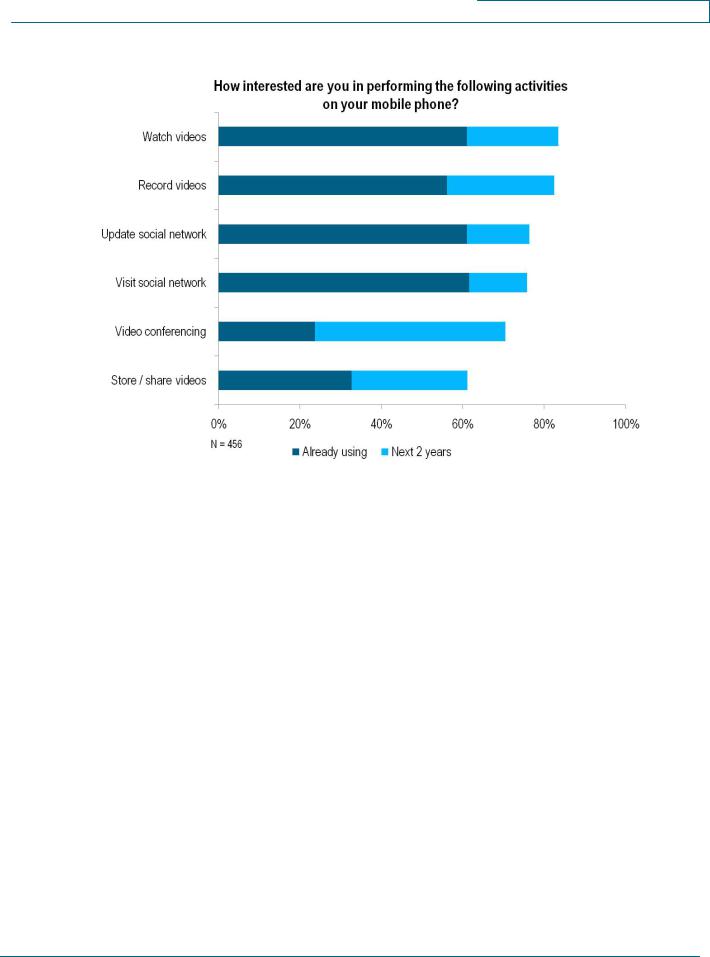
Point of View
Figure 5. Future Activities on Smartphones.
Source: Cisco IBSG, 2011
9. Wi-Fi is becoming the network access method of choice for many smartphone users. Increasingly, mobile apps and smartphones are employing Wi-Fi rather than traditional mobile networks to access the Internet (see Figure 6). On average, all smartphone users reported spending a stunning 35 percent of their time browsing the web on their devices through a Wi-Fi connection rather than a cellular network. In addition, regular Wi-Fi users split their time equally between Wi-Fi and cellular network connections.
Cisco IBSG © 2011 Cisco and/or its affiliates. All rights reserved. |
Page 7 |
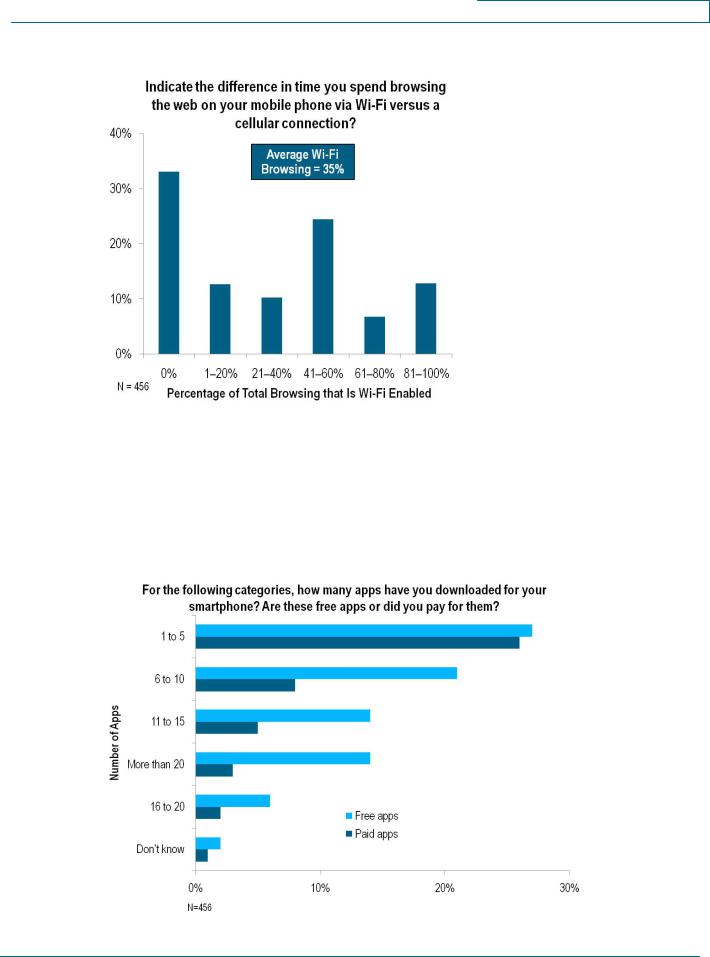
Point of View
Figure 6. Wi-Fi Access by Smartphone Users.
Source: Cisco IBSG, 2011
10. Both business users and consumers don’t want to pay for mobile apps. While 75 percent of smartphone users reported running apps on their devices, few are paying for them (see Figure 7). In all categories, free apps outnumbered paid ones by a sizable margin.
Figure 7. Paid Versus Free App Downloads (Smartphone Users).
Source: Cisco IBSG, 2011
Cisco IBSG © 2011 Cisco and/or its affiliates. All rights reserved. |
Page 8 |
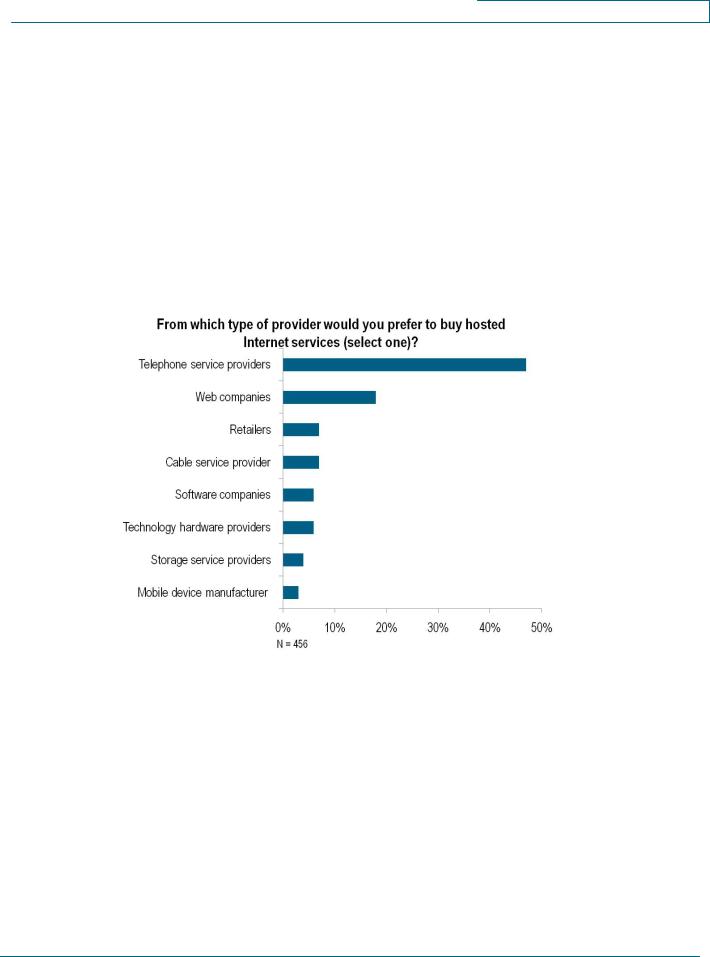
Point of View
Mobile Operators Are Well Positioned
With some well-publicized exceptions, mobile users seem to be very satisfied with all aspects of mobile service they receive, but especially with the overall experience, coverage, reliability, and customer support. On average, respondents rated their level of satisfaction with the overall mobile experience as 7.8 (out of 10). It seems that the mobile industry may have finally matured enough for users to accept more advanced mobile services—such as the mobile cloud.
Given this high degree of satisfaction, mobile users appear to be open to buying future mobile cloud services from their existing mobile providers. In fact, as Figure 8 shows, for close to 50 percent of respondents, SPs were their preferred channel, dwarfing the less than 20 percent who prefer web companies.
Figure 8. Preferred Provider of Mobile Cloud Services (Smartphone Users).
Source: Cisco IBSG, 2011
In choosing a mobile cloud provider, respondents most valued the reliability of service, familiarity and strength of their current relationship, and the operator’s trusted brand. Mobile users who chose non-SP companies were also impressed with the reliability of service these providers deliver, but were attracted to the lower prices and better quality of customer care offered by web companies. Remarkably, mobile users perceived non-SP providers to be much stronger on security and data privacy. Respondents who preferred non-SP companies ranked security and data privacy as their third-highest selection criterion, while those who chose mobile operators as their preferred providers ranked security/data privacy sixth on their priority list.
Cisco IBSG © 2011 Cisco and/or its affiliates. All rights reserved. |
Page 9 |

Point of View
Delivering the Mobile Cloud Promise
The mobile cloud is already here, and the forecast looks to get even “cloudier” (a positive in this case). The Cisco IBSG research clearly demonstrates that mobile users are hungry for cloud-delivered services. In fact, many of them are already using several basic and more advanced mobile cloud services, and are eager to use the next generation of services and integrated cloud solutions.
The good news for mobile providers is that mobile customers are generally satisfied with their current provider relationships and view mobile operators as a natural and preferred source for mobile cloud services. Operators also have a strong brand and relationship with customers that they can extend to become customers’ premier mobile cloud provider.
On the other hand, users recognize the importance of the network for delivering mobile cloud services. More than one-third of respondents cited “the need for constant connectivity” as their primary concern in moving applications and data to the cloud. To make the mobile cloud a reality, SPs should ensure the network infrastructure is robust and always available. The reliability of mobile networks will need to approach that of terrestrial networks to gain user confidence.
SPs need to consider several important implications and potential strategies to capture the explosive mobile cloud opportunity:
●Create new, mobile-centric cloud services. Develop a portfolio of innovative cloud services that exploit the unique features of mobile devices (e.g., cameras and location identification) to create a diverse range of new and exciting mobile solutions.
●Strongly position the mobile cloud. The window of opportunity for the mobile cloud will not last long. Mobile operators must gain the high ground through aggressive marketing and brand positioning as the natural provider of cloud services.
●Differentiate with unique capabilities. SPs alone have the ability to integrate their networks and unique capabilities with IT. Mobile operators should exploit these natural advantages to deliver new and differentiated services. Equally, operators need to aggressively take advantage of the reasons mobile users view them as their preferred provider of mobile cloud services.
●Develop an integrated device strategy. Recognize that devices and mobile cloud services are co-dependent by promoting new, cloud-centric devices as enabling platforms to deliver superior customer experiences and drive demand for mobile cloud services. SPs should also create attractive pricing and marketing campaigns to encourage users of basic mobile phones to upgrade to smartphones.
●Create cloud services targeted at business users. Develop a range of businesscentric mobile cloud offerings that allow employees to be more productive. In addition, befriend IT departments by providing them with an effective means of meeting their challenging demands of simplicity, security, and device management. Ensure these services integrate with consumer offerings to enable users to maintain multiple mobile personas.
●Deliver the promise of fixed mobile convergence (FMC). Cloud services and delivery models are the means to deliver on the long-promised FMC vision. Integrated wireline and mobile operators should develop converged offerings based on cloud
Cisco IBSG © 2011 Cisco and/or its affiliates. All rights reserved. |
Page 10 |
